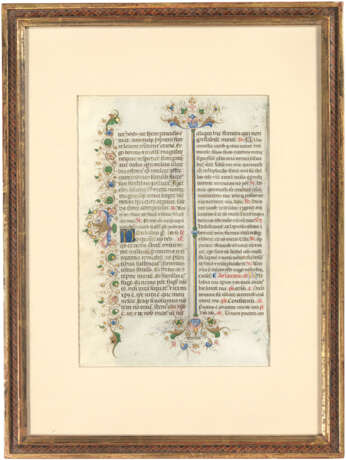ID 381208
Lot 3 | Ferrarese illuminator
Estimate value
£ 2 500 – 3 500
Two delightfully decorative leaves from a lavish manuscript originally made for Lionello d’Este, Marquis of Ferrara and Duke of Modena and Reggio Emilia from 1441 to 1450. An example of the pinnacle of manuscript production in Ferrara at the height of the Renaissance.
Each 275 x 199mm. Two columns of 30 lines written in brown ink in a gothic bookhand, rubrics in red, the first leaf with five two-line illuminated initials in gold on grounds alternately of pink or blue, the second leaf with two, one-line initials in blue or gold, full-length bar borders of burnished gold (slightly cockled, the margins lightly thumbed). Framed (405 x 305mm each)
Provenance: (1) All aspects of the manuscript — size, format and illumination — correspond to those of the Missal of Borso d'Este, marquis and then duke of Ferrara (Modena, Biblioteca Estense, Ms W.5.2, lat. 239) and the Breviary was certainly made either for him or his predecessor Lionello, and intended, like the Missal, for use in the ruler’s chapel. It is now usually identified with the Breviary recorded in accounts in the d’Este archives as having been illuminated for Lionello by Giorgio d’Alemagna, Bartolomeo di Benincà, Guglielmo Giraldi and Matteo de' Pasti. (2)The parent manuscript was sold at Christie’s, 8 December 1958, lot 190, as part of the estate of the 2nd Baron Llangattock. It carried the bookplate of John Etherington Welch Rolls (1807-1870), father of the 1st Baron Llangattock. Many miniatures had already been removed (supposedly by soldiers during the Peninsular War) and after the sale the remaining leaves were separated and dispersed. Sister leaves were sold most recently at Christie’s, 24 November – 3 December 2015, lots 27 and 28.
Content: The text on the first leaf comprises lessons to be read on the second Sunday of Lent; the text on the second leaf is from the first, second and third lessons to be read on Holy Saturday.
| Address of auction |
CHRISTIE'S 8 King Street, St. James's SW1Y 6QT London United Kingdom | |
|---|---|---|
| Preview |
| |
| Phone | +44 (0)20 7839 9060 | |
| Buyer Premium | see on Website | |
| Conditions of purchase | Conditions of purchase |






